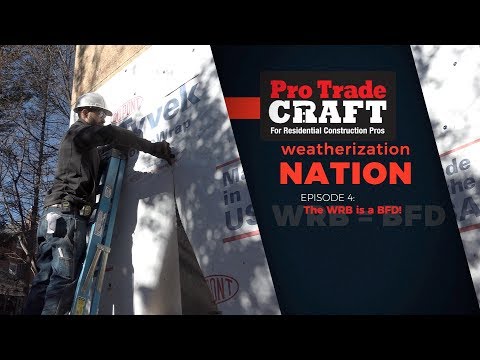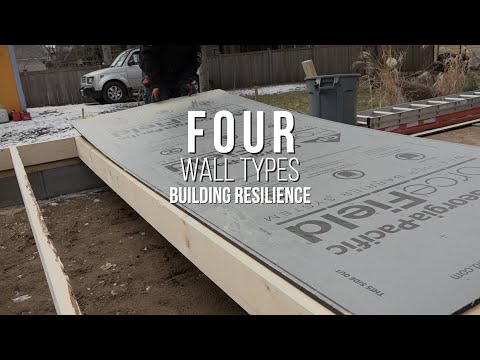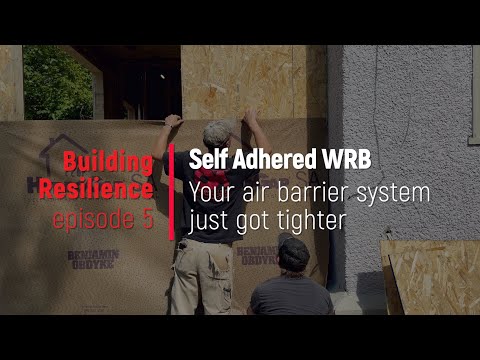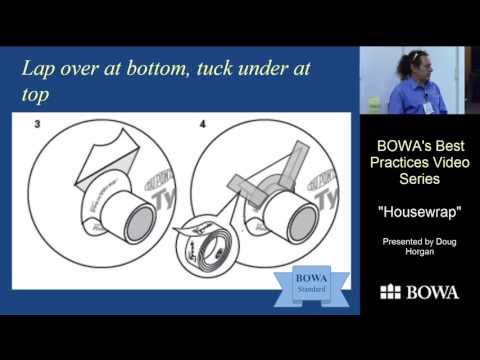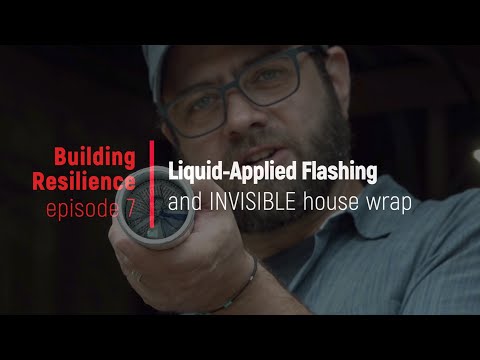Welcome to ProTradeCraft’s Weatherization Nation. A show about building smart from the start. See all of the episodes here
Last week we covered the walls with Tyvek, a Weather Resistive Barrier. We also learned how to upgrade it to an air barrier and cleared up a common misconception that we at Protradecraft see on our many travels around the continent:
Tyvek is a weather barrier, and it can be an air barrier, but Tyvek is not a vapor barrier.
Terrence: Tyvek is NOT a vapor barrier. It allows vapor to pass through it and dry out through diffusion.
A vapor barrier would be like a solid piece opf plastic that is not going to allow any air or moisture through it.
[Tyvek] is a water and air barrier, Tyvek is not a vapor barrier.
Sketch Desk: Integrating a window into a WRB
This week, we’re going to cut a hole in that air and weather barrier and install a leak-free window.
Tyvek specifies an I shape, folding the sides into the rough opening.
They also spec a flap cut at the top.
At the bottom, it is good to slope the sill, such as with a piece of beveled siding.
Use flexible flashing to fashion a sill pan that directs water out.
Next, apply sealant either to the wall around the opening or to the back of the window flanges. Apply it along the top and sides, and put the window in the hole.
When the bottom is level, and the window is square, nail it off.
The side flanges are then sealed to the Tyvek with flashing tape as is the top flange. Do not extend the sides above the head flashing, but DO extend the head past the sides, and the sides past the bottom.
Now you can flip that flap down, and tape the edges against water or air leaks.
With the outside weather tight, we can walk inside and seal the perimeter with low-expansion canned foam. Some carpenters like to use a sealant at the bottom rather than foam because it does not expand at all.
Now that we’ve done it in animation land let’s see how it’s done in the real world.
Git ‘er Done: Install a weathertight window in a wall
First, Ray locates the opening by pushing against the Tyvek, and he cuts the I hole.
He cuts the top flap about four inches high to make space for the three-inch flashing tape that’ll
Ray: OK, we’ve got a good four-inch flap there.
He tacks the flap in place and indulges in a jobsite joke with Victor.
Ray: Then, like I said, what I like to do, I’m going to cut this back in the middle of the jamb...
...where the end can be sealed into the framing later with perimeter foam.
Sill pan flashing protects the bottom of the window framing
Now it is time for the FlexWrap pan flashing, which is cut to be 12 inches longer than the rough opening.
Ray: We’ll fold it in half,
Peeling back the inner portion of the split release paper
start from one side
He places the center of the flashing into the center of the rough opening.
Make sure we’ve got a minimum of two inches sticking out.
Work it as we go, to avoid any dimpling in the corners.
He uses a speed square to fit the flashing tightly into the corner.
Make sure we’ve got a minimum of six inches coming up the side.
Ray moves to the other end of the pan, flashing working it as he goes.
Ray: work it as you go…
He peels off the last of the release paper and works the flashing around the corner and onto the face of the wall.
It’s essential to use a roller or squeegee or some other tool to work the flashing tape into the substrate. Pushing the adhesive into the pores of the substrate will yield superior performance.
Apply sealant to the window flange sides and top
Ray spreads sealant on the back of the window flange, covering the nail holes.
Terrence, the Tyvek specialist points out that the nail holes are about as far toward the inner edge as the sealant should be placed; that it’s best to place the bead toward the outer edge of the flange to make sure the sealant beds into the wall when the window is placed in the opening.
No sealant is applied to the bottom flange, to allow water to drain out.
It looks like his bead placement was just right.
Ray: Go ahead, Victor and nail this side.
Ray levels the bottom, and Victor nails the bottom corners.
On a small window like this, it is unlikely that the unit will be out of square, but because the camera is rolling Ray checks the sides for plumb and the top for level.
Ray: Let me double-check, Victor make sure we’re still square.
When Ray is satisfied that the window is level, plumb, and square, Victor nails it off.
Integrate the window into the WRB
The window is now integrated with the house wrap along its sides and bottom. It is integrated with the wall sheathing at its top.
To seal the perimeter further against any water or air leaks, they use StraightFlash on the jambs and head.
The jamb flashing extends about an inch past the top of the window so that the head flashing tape will bury it. Again, rolling the tape to assure maximum adhesion.
The bottom of the window remains unsealed so that any water that ever works its way into the window opening will be able to drain out. The inside of the window opening will be sealed with low-expansion GreatStuff for the air seal, but the outside of the bottom remains unsealed to allow drainage.
After installing the head flashing to extend beyond the jamb flashings, Victor seals the final flap on the edges with Tyvek tape.
He also places one small piece of tape in the center of the flap to keep it closed, but to also allow water from above to drain out.
Where we're going next time: a new rain screen product for siding
That pretty much wraps up this episode.
Next time, we’ll install a new rainscreen product called DrainVent, which allows the walls to dry out should any water sneak in.
Previously: The WRB is a BFD
